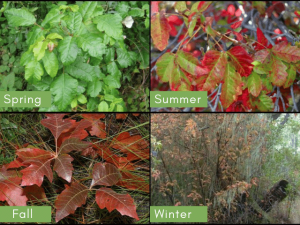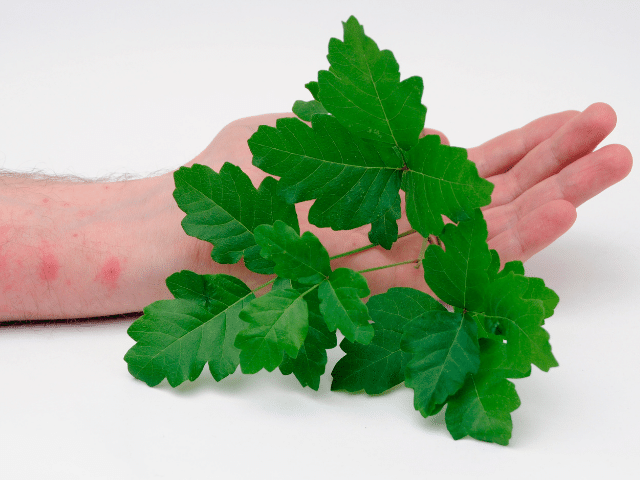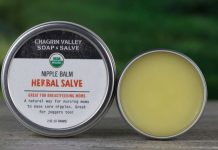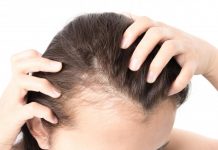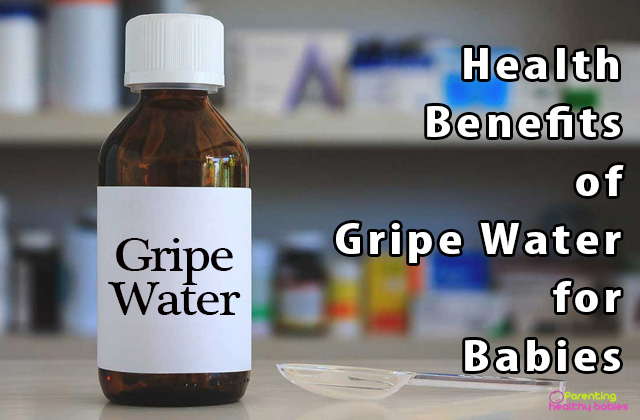7 out of 10 people are allergic to poison ivy plants. Hence the name starts with the word ‘poison’. It is a very common plant in many parts of the United States. Along with poison ivy, there are other two similar plants. They are called poison oak and poison sumac. They are known to cause allergic reaction to your kids.
Kids wandering about in woods or any garden can get infected by these plants. It is very common. It is caused by certain kind of oil excreted by the plant. The oil can also get wiped off to other objects like toys, furniture and pets. In this way the poison remains for a long time. It is very risky because it makes your child irritable and causes them immense discomfort.
How to Identify Poison Ivy:
In the spring:
When it starts to blossom in the spring, its leaves are red or maybe a mixture of red and green.
In the summer:
During summer, poison ivy continues to mature and older leaves will become completely green, but new leaf growth will continue to start out as red.
In the fall:
During fall season, poison ivy will change color to bright orange, yellow, or red.
In the winter:
During the winter, poison ivy leaves turn deep red, then shrivel and fall off.
Causes of Poison Ivy Infection:
Children staying near areas with more plants are at risk of contamination. There are majorly three different kinds of plants which causes poison ivy infection amongst kids.
- Poison Ivy: Shrubs and vines of this plant can be found in the western part of the United States.
- Poison Oak: Poison oak is another similar plant where there are climbing vines and shrubs and have leaves in a group of three. These plants are found in the western borders of the United States along with the Southeastern coasts.
- Poison sumac: This is a smaller tree with several leaves. The leaves are arranged in pairs. It grows in the western borders of the United States.
All of these, above mentioned plants, excrete a certain kind of oil. Whenever, your child touches a vine or leaf of the tree then the oil affects his/her skin. It is the immunity system of your child’s body which causes the rash, due to the allergic reaction. The poison is very strong. Even smokes coming out from burning the leaves of any of these plants might cause skin allergy.
Symptoms of Poison Ivy Infection
Your child might show symptoms of the infection within hours or even days after coming in contact with a poison ivy (or similar plants) plant. These are the few basic symptoms that he/she will show:
- Small bumps on the area where the oil touched the skin.
- The bumps will then get converted to blisters
- Certain redness and swelling in different areas.
- Extreme itchiness and irritation.
- Blisters will break and ooze fluid. It will also crust over. However, luckily the fluid coming out from the blisters will not cause further rashes.
The symptoms of the poison ivy infection are pretty much like any other infection in your child. That is why he/she needs proper treatment, once contaminant.
You should call or visit your doctor if your child is experiencing one of the following:
- Rashes on his/her face.
- Inhaled smokes from the burning of poison ivy plants.
- He/she is suffering from severe rashes.
- A major portion of his/her body is covered in rash.
Treatments of Poison Ivy Infection:
There are various home remedies and medications available for poison ivy infection. You can help relieve your child from the pain of the infection by following the below home remedies.
- Use colloidal oatmeal to bathe your child, once he/she shows first signs of infection. This will help him/her to ease the discomfort.
- Compress your child’s affected area with a cool and wet towel. Change the cloth or towel, after a while to make sure that thing is also not contaminated.
- You can use calamine lotion to sooth the skin irritation.
- Corticosteroid cream can also be applied on the skin to get the same effect.
- If the itching is so much so that your child is totally unable to sleep, then orally give him/her diphenhydramine liquid. This will help in calming down the irritation and have a sound sleep.
Apart from these home remedies there are certain medications which can be tried. However, these medications should only be applied under the advice of a doctor.
- Applying Corticosteroid cream
- Having Corticosteroid pills or liquid
- Taking corticosteroid injections
If poison ivy rashes are not treated and ignored, then it might lead way for a bacterial infection. This will lead to other severe health issues. Though most cases of poison ivy infection can be treated at home, timely intervention is needed.
Prevention Mechanism:
Poison ivy infection is very common. However, it can also be prevented quite easily. There are few things you need to ensure in order to prevent your child from getting infected with poison ivy plants.
The following are the steps:
- Educating your child along with other family members (including the nanny, in case you have one) about the different kinds of plants and what plants are dangerous.
- If your child is roaming around areas where there are many plants then make him/her wear dresses with long-sleeves, trousers, socks and shoes. Bare minimum amount of skin should be exposed to the plants.
- Put the clothes in the washing machine, right after your kids return home from the woods or from any area where various plants grow. This will reduce the risk of further contamination. Even if any hint of poison is left on the clothes, it will wash away. Make sure that you wash those clothes separately from other clothes you wear for regular use.
- Make sure that your child does not touch any furniture, toys or even your pet, right after returning from an area with many plants around it. If he/she has touched any toys or furniture then wash them too. Also give your pet a bath if your child has touched it after or during his/her visit to the wood or the gardens.
- Finally, make sure that your child takes a good bath, in warm water with soap, right after coming back from the place. Make sure he/she washes every part of his/her body so that no traces of the poisonous oil can remain in contact with the child.
Things to Consider:
- Check things before it gets worse. If your child is showing signs of itchiness or irritation then apply soothing lotions on the skin.
- In most cases poison ivy infection can be treated at home. So, there is no reason to get alarmed.
- In worst case scenario, the blisters might make way for further infection. So, if you think that the home remedies are not working properly then you must consult your doctor. In that case he/she should get oral medication of injections.
- Try and keep track of the time of your child’s visit to the woods or the gardens where there are several large plants. A close monitoring is important to make sure how long the oil is touch with your child’s skin.
- Keep track of all the things he/she touched since then. The oil can stay there for a very long time

